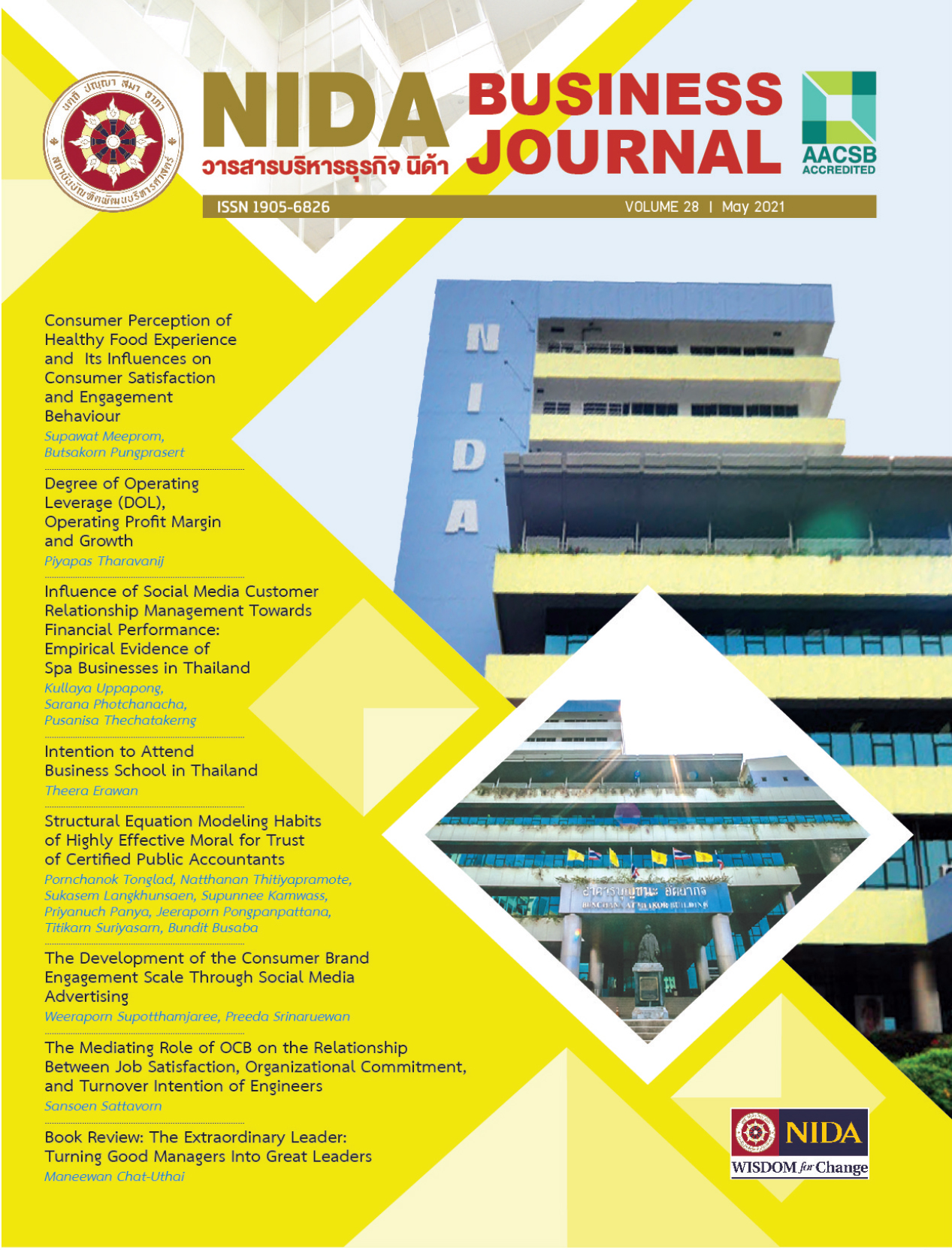อิทธิพลของการจัดการลูกค้าสัมพันธ์ทางสื่อสังคมต่อผลประโยชน์ ทางการเงินองค์กร: หลักฐานเชิงประจักษ์ธุรกิจสปาในประเทศไทย
คำสำคัญ:
การจัดการลูกค้าสัมพันธ์ทางสื่อสังคม, สื่อสังคม, ต้นทุนธุรกรรม, ผลประโยชน์ทางการเงินบทคัดย่อ
การจัดการลูกค้าสัมพันธ์ทางสื่อสังคม (Social Media Customer Relationship Management: SM CRM) เป็นเครื่องมือทางการตลาดที่สำคัญในยุคสื่อสังคม มุ่งเน้นการสร้าง พัฒนา และรักษาความสัมพันธ์กับลูกค้าผ่านช่องทาง สื่อสังคม การศึกษานี้เป็นการวิจัยเชิงปริมาณ เพื่อค้นหารูปแบบการใช้ SM CRM ที่ส่งผลต่อผลประโยชน์ทางการเงินที่ผ่าน ตัวแปรส่งผ่าน คณะผู้วิจัยใช้ทฤษฎีต้นทุนธุรกรรม (Transaction Costs Theory) เป็นตัวแปรส่งผ่าน โดยทำการศึกษากับ ผู้ประกอบการธุรกิจสปาในประเทศไทยที่ขึ้นทะเบียนนิติบุคคลกับสำนักงานส่งเสริมวิสาหกิจขนาดกลางและขนาดย่อม จำนวน 157 ราย โดยใช้แบบสอบถามเก็บรวบรวมข้อมูลและนำข้อมูลทดสอบสมมติฐานวิจัย ด้วยการวิเคราะห์สมการ เชิงโครงสร้าง ซอฟต์แวร์ SmartPLS3 ผลการศึกษาพบว่าผู้ประกอบการธุรกิจสปาที่มีการใช้ SM CRM ทั้งด้านการตลาด ด้านการขาย หรือด้านการบริการ มีอิทธิพลทางตรงและทางอ้อมต่อผลประโยชน์ทางการเงินเพิ่ม ได้แก่ ผลกำไร ผลตอบแทน จากการลงทุน ลูกค้ารายใหม่ สามารถลดต้นทุนและส่วนแบ่งทางการตลาด ผลประโยชน์ทางการเงินเพิ่มขึ้น อีกทั้งการใช้ SM CRM ของธุรกิจสปาส่งผลต่อการลดต้นทุนธุรกรรม และการลดต้นทุนดังกล่าวนำไปสู่ผลประโยชน์ทางการเงินเพิ่มขึ้น
References
Acker, O., Gröne, F., Akkad, F., Pötscher, F., & Yazbek, R. (2011). Social CRM: How companies can link into the social web of consumers. Journal of Direct, Data and Digital Marketing Practice, 13(1), 3-10.
Aldaihani, F. M. F., & Ali, N. A. B. (2018). Impact of social customer relationship management on customer satisfaction through customer empowerment: A study of islamic banks in kuwait. International Research Journal of Finance and Economics, 170, 41-53.
Ang, L. (2011). Is SCRM really a good social media strategy? Journal of Database Marketing & Customer Strategy Management, 18(3), 149-153.
Arman, S. M. (2014). Integrated model of social media and customer relationship management: A literature review. International Journal of Information, Business and Management, 6(3), 118-131.
Armstrong, J.S., & Overton, T.S. (1977). Estimating Nonresponse Bias in Mail Surveys, Journal of Marketing Research, 14(3), 396-402.
Bagozzi, R. P., & Yi, Y. 1988. On the evaluation of structural equation models. Journal of the Academy of Marketing Science, 16(1), 74-94.
Ballings, M., & Van den Poel, D. (2015). CRM in social media: Predicting increases in Facebook usage frequency. European Journal of Operational Research, 244(1), 248-260.
Band, W., & Petouhoff, N. L. (2010). Topic overview: Social CRM goes mainstream. cambridge: Forrester Research Inc.
Baron, R. M., & Kenny, D. A. (1986). The moderator-mediator variable distinction in social psychological research: Conceptual, strategic, and statistical considerations. Journal of Personality and Social Psychology, 51, 1173-1182.
Berry, L. L. & Parsuraman, A. (1991) Marketing services–competing through quality, New York: Free Press.
Bhatti, M. A., Farhan, M., Ahmad, M. J., & Sharif, N. (2019). The impact of social CRM capabilities and customer engagement on the firm performance: Mediating role of social media usage. Pakistan Journal of Humanities and Social Scienecs, 7(3), 313-324.
Blau, P. M. (1964). Exchange and power in social life, John Wiley & Sons, Inc., New York, NY.
Brouthers, K. D., & Nakos, G. (2004). SME entry mode choice and performance: A transaction cost perspective. Entrepreneurship Theory and Practice, 28(3), 229-247.
Bukola, A. A., Abosede, A. G., & Adesola, M. A. (2019). Customer relationship management and small and medium enterprises performance: Pragmatic evidence from Oyo State, Nigeria. Asian Journal of Education and Social Studies, 5(2) 1-9.
Chang, W., Park, J. E., & Chaiy, S. (2010). How does CRM technology transform into organizational performance? A mediating role of marketing capability. Journal of Business Research, 63(8), 849-855.
Cheng, C.-F., & Lee, A.-H. (2011). The influences of relationship marketing strategy and transaction cost on customer satisfaction, perceived risk, and customer loyalty. African Journal of Business Management, 5(13), 5199.
Choudhury, M. M., & Harrigan, P. (2014). CRM to social CRM: The integration of new technologies into customer relationship management. Journal of Strategic Marketing, 22(2), 149-176.
Dalla Pozza, I., Goetz, O., & Sahut, J. M. (2018). Implementation effects in the relationship between CRM and its performance. Journal of Business Research, 89, 391-403.
Davis, F. D. 1989. Perceived use fullness, Perceived Ease of use and user acceptance of information technology. MIS Quarterly, 13(3), 319-339.
Dewnarain, S., Ramkissoon, H., & Mavondo, F. (2019). Social customer relationship management: An integrated conceptual framework. Journal of Hospitality Marketing & Management, 28(2), 172-188.
Domi, S., Capelleras, J. L., & Musabelliu, B. (2020). Customer orientation and SME performance in Albania: A case study of the mediating role of innovativeness and innovation behavior. Journal of Vacation Marketing, 26(1), 130-146.
Foltean, F. S., Trif, S. M., & Tuleu, D. L. (2019). Customer relationship management capabilities and social media technology use: Consequences on firm performance. Journal of Business Research, 104, 563-575.
Fornell, C. & Larker, D. F., (1981). Evaluating structural equation models with unobservable variables and measurement error. Journal of Marketing Research, 18(February), 39-50.
Garg, P., Gupta, B., Dzever, S., Sivarajah, U., Kumar, V., (2020). Examining the relationship between social media analytics practices and business performance in the Indian retail and IT industries: The mediation role of customer engagement. International Journal of Information Management, 52, 102069. https://doi.org/10.1016/j.ijinfomgt.2020.102069
Gersick, C. (1991). Revolutionary change theories: A multilevel exploration of the punctuated equilibrium paradigm. Academy of Management Review, 16(1), 10-36.
Greenberg, P. (2010). The impact of CRM 2.0 on customer insight. Journal of Business & Industrial Marketing, 25(6), 410-419.
Greenwood, R. and Hinings, C. R. (1996). Understanding radical organizational change: Bringing together the old and the new institutionalism. The Academy of Management Review, 21(4), 1022-1054.
Gulbrandsen, B., Jay Lambe, C., & Sandvik, K. (2017). Firm boundaries and transaction costs: The complementary role of capabilities. Journal of Business Research, 78, 193-203.
Gurbaxani, V., & Whang, S. (1991). The impact of information systems on organizations and markets. Communications of the ACM, 34(1), 59-73.
Hair, J. F., Black, W. C., Babin, B. J., & Anderson, R. E. (2010). Multivariate data analysis: A global perspective, (7th ed). New Jersey: Pearson Education Inc.
Harrigan, P., Soutar, G., Choudhury, M. M., & Lowe, M. (2015). Modelling CRM in a social media age. Australasian Marketing Journal, 23(1), 27-37.
Hastings, G. and Saren, M. 2003. The Critical Contribution of Social Marketing: Theory and Application. Marketing Theory, 3(3), 305-322.
Heller Baird, C., & Parasnis, G. (2011). From social media to social customer relationship management. Strategy and Leadership, 39(5), 30-37.
Huges, A.M. (2002). Editorial: The mirage of CRM. Journal of Database Marketing, 9(2), 102-104.
Hunt, S. D., Arnett, D. B., & Madhavaram, S. (2006). The explanatory foundations of relationship marketing theory. Journal of Business & Industrial Marketing, 21(2), 72-87.
Jarukit, M. (2020). Spa-Massage: A market with tens of thousands of main players and another one in the stock market. https://marketeeronline.co/archives/138860
Jayachandran, S., Sharma, S., Kaufman, P. & Raman, P. (2005). The role of relational information processes and technology use in customer relationship management. Journal of Marketing, 69(4), 177-192.
Kemp, S. (2020). Digital 2020: Thailand. https://datareportal.com/reports/digital-2020-thailand
Krasnikov, A., Jayachandran, S. & Kumar, V. (2009). The impact of customer relationship management implementation on cost and profit efficiencies: Evidence from the U.S. commercial banking industry. Journal of Marketing, 73(6), 61-76.
Kumar, K., Subramanian, R., & Yauger, C. (1998). Examining the market orientation–performance relationship: A context-specific study. Journal of Management, 24(2), 201-233.
Küpper, T., Jung, R., Lehmkuhl, T., Walther, S., & Wieneke, A. (2014, June 1-5). Performance measures for social CRM: A literature review [Conference sesing]. 27th Bled eConference, Bled, Slovenia. https://domino.fov.uni-mb.si/proceedings.nsf/0/400cee09cde2a24ec1257cee0042e351/$FILE/09_K%C3%BCpper_Jung_Lehmkuhl_Walther_Wieneke.pdf
Lawshe, C. H. (1975). A quantitative approach to content validity. Personnel Psychology, 28, 563-575.
Marino, V., & Lo Presti, L. (2018). Engagement, satisfaction and customer behavior-based CRM performance: An empirical study of mobile instant messaging. Journal of Service Theory and Practice, 28(5), 682-707.
Minh Ngo, V., Pavelkova, D., Thi Phan, Q. P., & Van Nguyen, N. (2018). Customer relationship managemaent (CRM) in small and Medium tourism enterprises: A dynamic capabilities perspective. Tourism and Hospitality Management, 24(1), 1-24.
Morgan, Robert M. & Shelby D. Hunt (1994). The commitment-trust theory of relationship marketing. Journal of Marketing, 58(July), 20-38.
Mosadegh, M. J., & Behboudi, M. (2011). Using social network paradigm for developing a conceptual framework in CRM. Australian Journal of Business and Management Research, 1(4), 63-71.
Müller, M., & Seuring, S. (2007). Reducing information technology-based transaction costs in supply chains. Industrial Management & Data Systems, 107(4), 484-500.
Nam. D., Lee J., & Lee H. (2019). Business analytics use in CRM: A nomological net from IT competence to CRM performance. International Journal of Information Management, 45, 233-245.
Niţu, V., Ionescu, A., Tileaga, C. and others. (2014). Evolution of CRM in SCRM. Economics Management and Financial Markets, (1), 303-310.
Nunnally, J. C. (1978). Psychometric theory (2nd ed.). New York: McGraw-Hill.
Parvatiyar, A., & Sheth, J. N. (2001). Customer relationship management: Emerging practice, process, and discipline. Journal of Economic and Social Research, 3(2), 1-34.
Payne, A. and Frow, P. (2005). A strategic framework for customer relationship management. Journal of Marketing, 69(4), 167-76.
Reinhold, O., & Alt, R. (2012, June 17-20). Social customer relationship management: State of the art and learnings from current projects [Conference session]. 25th Bled eConference. Bled, Solvenia. https://aisel.aisnet.org/cgi/viewcontent.cgi?article=1017&context=bled2012
Rindfleisch, A., & Heide, J. B. (1997). Transaction cost analysis: Past, present, and future applications. Journal of Marketing, 61(4), 30-54.
Ringle, C.M., Sarstedt, M., Straub, D.W., (2012). A critical look at the use of PLS-SEM in MIS quarterly. MIS Quarterly, 36(1), iii-xiv.
Ryals, L. and Knox, S. (2001). Cross-functional issues in the implementation of relationship marketing through customer relationship management. European Management Journal, 19(5), 534-542.
Schaupp, L. C., & Bélanger, F. (2014). The value of social media for small businesses. Journal of Information Systems, 28(1), 187-207.
Sheth, J.N., & Parvatiyar, A. (1995). Relationship marketing in Consumer markets: Antecedents and consequences. Academy of Marketing Science Journal, 23(4), 271-255.
Sohrabi, B., Haghighi, M. and Khanlari, A. 2010. Customer relationship management maturity model (CRM3): A model for stepwise implementation. International Journal of Human Sciences, 7(1), 1-20.
Soltani, Z., & Navimipour, N. J. (2016). Customer relationship management mechanisms: A systematic review of the state of art literature and recommendations for future research. Computer in Human Behavior, 61, 667-688.
Soltani, Z., Zareie, B., Milani, F. S., & Navimipour, N. J. (2018). The impact of the customer relationship management on the organization performance. The Journal of High Technology Management Research, 29(2), 237-246.
Soprasong, P. & Thongmak, M. (2015). Social Media Use in Thai SMEs: A Focus on Enhancing Customer Relationship. Journal of Information Systems in Business, 1(1), 86-101.
Teo, T. S. H., & Yu, Y. (2005) Online buying behavior: A transaction cost economics perspective. Omega, 33(5), 451-465.
Tohidi, H., & Jabbari, M. M. (2012). The necessity of using CRM. Procedia Technology, 1, 514-516.
Tomassen, S. (2004). The effects of transaction costs on the performance of foreign direct investments: An empirical investigation. Doctoral dissertation. Norway. BI Norwegian School of Managements.
Trainor, K. J., Andzulis, J. (Mick), Rapp, A., & Agnihotri, R. (2014). Social media technology usage and customer relationship performance: A capabilities-based examination of social CRM. Journal of Business Research, 67(6), 1201-1208.
Uppapong, K. & Thechatakerng, P. (2019). Social media customer relationship management model leading to the creation of financial benefits of business. Chulalongkorn Business Review, 41(1), 33-53. (in Thai)
Uppapong, K. (2019). Social media customer relationship management and performance in service business. (Doctoral disertation). Chiang Mai: Maejo University. (in Thai)
Williamson, O. (1985). The economic institutions of capitalism: Firms, markets, relational contracting. New York: Free Press.
Wongsansukcharoen, J., Trimetsoontorn, J., & Fongsuwan, W. (2015). Social CRM, RMO and business strategies affecting banking performance effectiveness in B2B context. Journal of Business & Industrial Marketing, 30(6), 742-760.
Woodcock, N., Green, A., & Starkey, M. (2011). Social CRM as a business strategy. Journal of Database Marketing & Customer Strategy Management, 18(1), 50-64.
Downloads
เผยแพร่แล้ว
How to Cite
ฉบับ
บท
License

This work is licensed under a Creative Commons Attribution-NonCommercial-NoDerivatives 4.0 International License.



